San Jacinto Mountains facts for kids
Quick facts for kids San Jacinto Mountains |
|
|---|---|
| Indian Land | |

The San Jacinto Mountains seen from Hemet
|
|
| Highest point | |
| Peak | San Jacinto Peak |
| Elevation | 3,302.3 m (10,834 ft) |
| Naming | |
| Native name | Error {{native name}}: an IETF language tag as parameter {{{1}}} is required (help) |
| Geography | |
| Country | United States |
| State | California |
| District | Riverside County |
| Range coordinates | 33°48′52″N 116°40′45″W / 33.81444°N 116.67917°W |
| Topo map | USGS San Jacinto Peak |
The San Jacinto Mountains (called Avii Hanupach in the Mojave language) are a mountain range in Riverside County. They are located east of Los Angeles in southern California, United States. These mountains are named after Saint Hyacinth, also known as San Jacinto in Spanish. He was a popular saint in Latin America.
Contents
Exploring the San Jacinto Mountains' Geography
This mountain range stretches for about 30 miles (48 km). It goes from the San Bernardino Mountains in the northwest to the Santa Rosa Mountains in the southeast. The San Jacinto Mountains are the northernmost part of the Peninsular Ranges. These ranges extend for about 1,500 km (930 mi) from Southern California all the way to the southern tip of the Baja California Peninsula.
The tallest point in the range is San Jacinto Peak, which is 3,302 meters (10,834 feet) high. The mountains also form a natural boundary for the Salton Watershed to the east.

The Coachella Valley lies along the eastern side of the mountains. This valley includes cities like Palm Springs and Rancho Mirage. The San Gorgonio Pass separates the San Jacinto Mountains from Mount San Gorgonio to the north. On the western side of the mountains, you'll find the community of Idyllwild. The range also marks the eastern edge of the growing Inland Empire region and the larger Greater Los Angeles area.
A large part of these mountains is protected. The Santa Rosa and San Jacinto Mountains National Monument was created in 2000 to preserve the area. Mount San Jacinto State Park is located near San Jacinto Peak. Part of the eastern side of the range is within the Agua Caliente Indian Reservation. In 1990, the California Legislature created the Coachella Valley Mountains Conservancy. This group works to protect the mountains around the Coachella Valley.
Understanding the Geology of the Mountains
The San Jacinto Mountains are like a huge block of rock that has been pushed up. This happened because of two major fault lines: the San Jacinto fault to the west and the San Andreas fault system to the east. These faults are cracks in the Earth's crust where large sections of rock move past each other.
The eastern and northern sides of the mountains have a very steep slope called a fault scarp. It rises from sea level to 10,000 feet in just a few miles! This steepness shows that the San Jacinto and San Andreas faults are very active. They can cause strong earthquakes. The last major earthquake on the southern part of these faults happened over 200 years ago. This means another strong earthquake is possible in the future, but scientists cannot predict exactly when. When strong earthquakes happen, rock slides from the mountains are possible. These slides could affect communities built close to the steep slopes on the desert side.
Climate and Weather in the San Jacinto Mountains
The San Jacinto Mountains are like a "humid island" surrounded by dry desert and semi-desert areas. This means they get more moisture than the land around them. The amount of rain and snow changes a lot depending on where you are on the mountain. At the western base, it gets about 15 inches of precipitation each year. On the eastern, desert side, it only gets about 6 inches. Higher up, above 5,500 feet, it can get as much as 32 inches. For example, the mountain town of Idyllwild gets about 27 inches per year.
The western side, closer to the coast, gets more rain and snow than the eastern, desert side. Most of the precipitation falls between November and March. There's also a smaller amount of rain from thunderstorms during the summer monsoon season, usually from July to September. The total amount of rain and snow can be very different from one year to the next. Snow usually falls above 4,000 feet in winter. Above 8,000 feet, snow can sometimes stay until June. Near the very top, you might even find small patches of snow that last all year in shady spots.
Flora and Fauna: Plants and Animals of the Mountains
The San Jacinto Mountains are like a "sky island" for many plants and animals. This means they are a cooler, wetter habitat surrounded by hot, dry valleys. Many species live here that cannot survive the very hot temperatures of the surrounding areas. The types of plants and trees you see on the mountains depend a lot on how high up you are and the climate.
At lower elevations, where it's often dry and hot, you'll find plants that can handle these conditions. Forests here include California black oak and Coulter pine. As you go higher up, the forests change. You'll see trees like Ponderosa pine, Jeffrey pine, Lodgepole pine, Incense cedar, White fir, and Red fir. There are also deciduous oak trees, which lose their leaves in the fall.
There's even a special grove of over 150 giant sequoia trees on the northeast side. These sequoias are naturally found in the Sierra Nevada Mountains. They were planted here by the U.S. Forest Service in the 1970s. Today, they are healthy and even producing new seedlings! Like in many other western U.S. areas, some forest trees have been lost recently due to bark beetles, especially during dry periods. Wildfires, such as the Mountain Fire and the Cranston Fire, have also burned some areas temporarily.
Human Use and Activities in the Mountains
Several communities are located within the San Jacinto Mountains. These include Idyllwild-Pine Cove, Mountain Center, and Pinyon Pines.
The native Cahuilla people lived in the deserts around the San Jacinto Mountains. They used the mountains for hunting, gathering food, and to escape the hot summer weather.
The mountains were also a favorite subject for artists like Carl Eytel and Paul A. Grimm, who lived in Palm Springs. Hollywood film directors have also used the mountains for movie scenes. For example, in Frank Capra's 1937 film, Lost Horizon, the Tahquitz Falls in Tahquitz Canyon was used as a filming location.
Today, the San Jacinto Mountains are a popular place for outdoor activities. The Pacific Crest Trail, a famous long-distance hiking trail, runs along the top of the range. A popular walking route goes from the Palm Springs Aerial Tramway Mountain Station above Palm Springs to the highest point of the range. This route has a relatively easy climb of 2,400 feet (730 meters) compared to other, steeper paths. Above Idyllwild, you can find historic Tahquitz Peak and other areas popular for rock climbing.
San Jacinto Wilderness: A Protected Area
The San Jacinto Wilderness was created in 1964 by the U.S. Congress as part of the original Wilderness Act. This protected area covers two sections: one north and one south of Mount San Jacinto State Park, where San Jacinto Peak is located. The wilderness area is 32,168 acres (about 130 square kilometers) in size. It is all within the San Bernardino National Forest and is managed by the U.S. Forest Service. This protection helps keep the natural environment wild and untouched for future generations.
See also
 In Spanish: Sierra de San Jacinto para niños
In Spanish: Sierra de San Jacinto para niños



